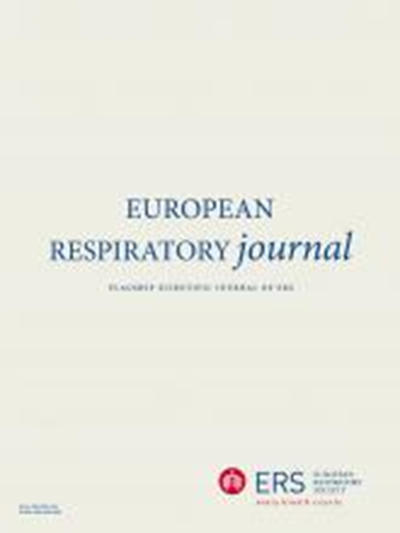Prognostication in patients with idiopathic pulmonary fibrosis using quantitative airway analysis from HRCT: a retrospective study.
IF 21
1区 医学
Q1 RESPIRATORY SYSTEM
引用次数: 0
Abstract
BACKGROUND Predicting shorter life expectancy is crucial for prioritizing antifibrotic therapy in fibrotic lung diseases, where progression varies widely, from stability to rapid deterioration. This heterogeneity complicates treatment decisions, emphasizing the need for reliable baseline measures. This study focuses on leveraging artificial intelligence model to address heterogeneity in disease outcomes, focusing on mortality as the ultimate measure of disease trajectory. METHODS This retrospective study included 1744 anonymised patients who underwent high-resolution CT scanning. The AI model, SABRE (Smart Airway Biomarker Recognition Engine), was developed using data from patients with various lung diseases (n=460, including lung cancer, pneumonia, emphysema, and fibrosis). Then, 1284 high-resolution CT scans with evidence of diffuse FLD from the Australian IPF Registry and OSIC were used for clinical analyses. Airway branches were categorized and quantified by anatomic structures and volumes, followed by multivariable analysis to explore the associations between these categories and patients' progression and mortality, adjusting for disease severity or traditional measurements. RESULTS Cox regression identified SABRE-based variables as independent predictors of mortality and progression, even adjusting for disease severity (fibrosis extent, traction bronchiectasis extent, and ILD extent), traditional measures (FVC%, DLCO%, and CPI), and previously reported deep learning algorithms for fibrosis quantification and morphological analysis. Combining SABRE with DLCO significantly improved prognosis utility, yielding an AUC of 0.852 at the first year and a C-index of 0.752. CONCLUSIONS SABRE-based variables capture prognostic signals beyond that provided by traditional measurements, disease severity scores, and established AI-based methods, reflecting the progressiveness and pathogenesis of the disease.利用HRCT定量气道分析预测特发性肺纤维化患者预后:一项回顾性研究
预测较短的预期寿命对于纤维化性肺病的抗纤维化治疗的优先级至关重要,这些疾病的进展变化很大,从稳定到迅速恶化。这种异质性使治疗决策复杂化,强调需要可靠的基线测量。本研究的重点是利用人工智能模型来解决疾病结果的异质性,重点是死亡率作为疾病轨迹的最终衡量标准。方法回顾性研究纳入1744例接受高分辨率CT扫描的匿名患者。人工智能模型SABRE(智能气道生物标志物识别引擎)是根据各种肺部疾病(n=460,包括肺癌、肺炎、肺气肿和纤维化)患者的数据开发的。然后,来自澳大利亚IPF登记处和OSIC的1284张高分辨率CT扫描显示弥漫性FLD,用于临床分析。根据解剖结构和体积对气道分支进行分类和量化,然后进行多变量分析,以探讨这些分类与患者进展和死亡率之间的关系,调整疾病严重程度或传统测量方法。结果:scox回归将基于sabre的变量确定为死亡率和进展的独立预测因子,甚至调整了疾病严重程度(纤维化程度、牵引性支气管扩张程度和ILD程度)、传统测量方法(FVC%、DLCO%和CPI)以及先前报道的用于纤维化量化和形态学分析的深度学习算法。SABRE联合DLCO可显著改善预后,第一年AUC为0.852,c指数为0.752。结论基于ssabre的变量捕获的预后信号超出了传统测量、疾病严重程度评分和已建立的基于人工智能的方法,反映了疾病的进展和发病机制。
本文章由计算机程序翻译,如有差异,请以英文原文为准。
求助全文
约1分钟内获得全文
求助全文
来源期刊

European Respiratory Journal
医学-呼吸系统
CiteScore
27.50
自引率
3.30%
发文量
345
审稿时长
2-4 weeks
期刊介绍:
The European Respiratory Journal (ERJ) is the flagship journal of the European Respiratory Society. It has a current impact factor of 24.9. The journal covers various aspects of adult and paediatric respiratory medicine, including cell biology, epidemiology, immunology, oncology, pathophysiology, imaging, occupational medicine, intensive care, sleep medicine, and thoracic surgery. In addition to original research material, the ERJ publishes editorial commentaries, reviews, short research letters, and correspondence to the editor. The articles are published continuously and collected into 12 monthly issues in two volumes per year.
 求助内容:
求助内容: 应助结果提醒方式:
应助结果提醒方式:


